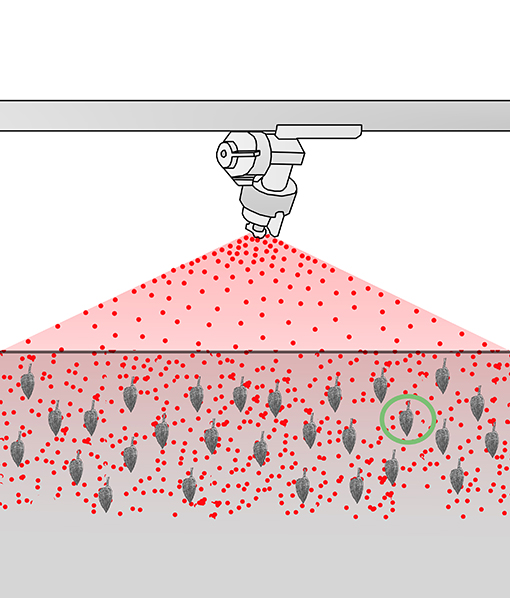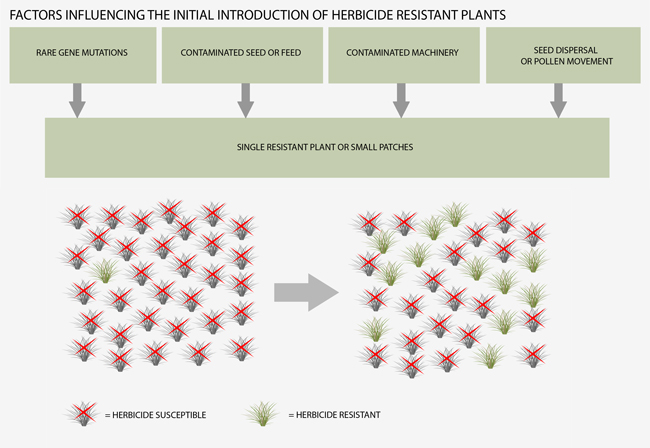
Recognising, managing and preventing herbicide resistance in serrated tussock
Serrated tussock (Nassella trichotoma) is a Weed of National Significance causing major agricultural and environmental impacts in Australia. Herbicides registered for control of serrated tussock in pastures are flupropanate, glyphosate and 2, 2-DPA. Flupropanate is widely regarded as the most selective and effective herbicide for serrated tussock control, however serrated tussock has become resistant to flupropanate in some areas.
Flupropanate is a soil-active herbicide that can prevent serrated tussock from germinating for 3 to 9 months in most situations. The residual effect is diminished by rainfall. One application can control germinating serrated tussock seedlings with effectiveness varying with soil type and rainfall.
Flupropanate-resistant serrated tussock was first identified on a Victorian property in 2002 and has since been confirmed in several locations from Armidale to Goulburn in New South Wales and Diggers Rest and the Rowsley Valley in Victoria.
In 2018, a targeted survey in the NSW Southern Tableland identified 28 populations as having strong levels of resistance and 15 developing resistance. It is therefore likely that other regions may have developed cases of resistance because surveys tend to underestimate the real levels of resistance.
This factsheet provides information to help land managers identify and manage flupropanate-resistant serrated tussock. It also provides important information on how to prevent herbicide resistance.
What is herbicide resistance?
Herbicide resistance is the ability of a plant to survive and reproduce following exposure to a dose of herbicide that would normally be lethal.
In a plant, resistance usually occurs through natural selection resulting from random and infrequent genetic mutations.
Susceptible plants are killed while herbicide-resistant plants survive to reproduce. If the herbicide treatment is repeated the resistant plants can successfully reproduce and become dominant in the population.
The appearance of herbicide resistance in a plant population is an example of rapid weed evolution and typically develops when a weed species has been exposed to 10-20 applications of flupropanate.
Large weed populations increase the likelihood of resistance developing.

Serrated tussock resistance to flupropanate
The serrated tussock seed bank may consist of millions of seeds of which many will germinate depending on environmental cues (Figure 1). The initial frequency of resistant genes in the population is likely to be extremely low. However, the likelihood of an individual resistant plant occurring is increased when seed banks are large. Once herbicide application has occurred, the resistant serrated tussock plant will survive the effects of the herbicide and continue to reproduce and spread the resistance (Figure 2). Resistant seed may enter a property in contaminated feed or seed, on machinery or through natural seed dispersal. Although resistant Serrated Tussock spread via these vectors, it is also very possible it can develop on farm due to continued application of flupropanate.
The implications of serrated tussock resistance to flupropanate include:
- Increased dominance of serrated tussock as a weed and reduced grazing opportunities for stock;
- Increased costs to land managers;
- More herbicide usage and increased time spent by land managers controlling serrated tussock;
- Understanding how to better use other herbicides and a need for research to find alternative herbicide mode-of-actions that control serrated tussock (NSW DPI was successful at conducting research and obtaining a Minor Use Permit (number 9792) that allows alternative herbicides for control of serrated tussock - expires 30 November 2025); and
- The need to actively manage pastures with serrated tussock using integrated weed management principles.
How do I know if the serrated tussock I manage has resistance?
Monitoring spray results regularly and knowing what to look for is the key to identifying herbicide resistance at the critical early stages. The best time to check spray results is between 6 and 12 months after application.
Flupropanate is a slow-acting herbicide that requires rainfall for its activation and may take as long as 12 months in some situations to kill mature serrated tussock plants. This can be confusing for land managers who forget when treatments have been undertaken.
- Keep careful records of when and where serrated tussock has been treated and the effects.
- Watch your paddocks! Look out for live serrated tussock plants or new seedlings amongst dead serrated tussock in paddocks that have been blanket treated (boom sprayed) with flupropanate in the last 12 months.
Ways to avoid herbicide resistance

- Most importantly do not rely solely on herbicides to control infestations.
- Do not use long term residual herbicides such as flupropanate continuously over the same area.
- Avoid continual use of herbicides with the same mode of action on large populations of serrated tussock.
- Regularly rotate herbicides types with different modes of action, for example, Group J herbicides (flupropanate and 2,2-DPA) with Group M herbicides (glyphosate).
- Integrate herbicide use with other control methods including chipping, cultivation, mulching, cropping, pasture rehabilitation, fire, grazing management, forestry/native revegetation, strategic fencing, use of shelter belts/windbreaks, slashing, and vehicle/machinery hygiene.
- Identify and monitor surviving weed populations and check for resistant weeds on your farm. Keep good records of treatments and weed populations. Attend chemical application and integrated weed management training courses.
- Report suspected herbicide resistance to your local weeds officer.
- Monitor and remove (chip out) any regrowing (potentially resistant) serrated tussock plants. Aim not to let any serrated tussock plant set seed.
- Glyphosate can be used to treat any seedlings that emerge after larger areas have been treated with flupropanate, but treat quickly to avoid seed set.
For more information on control of serrated tussock see the Serrated Tussock National Best Practice Management Manual.
Acknowledgements
This factsheet is based on the Information Note published and authorised by the Victorian Department of Primary Industries (VIC DPI). The project was funded under an Australian Government Initiative and by the Victorian Department of Primary Industries.
Authors: David McLaren, Charles Grech
Editor: Elissa van Oosterhout
Reviewers: Birgitte Verbeek, Tony Cook, Janene Kidston, Linda Ayres
Revised February 2019 by Tony Cook, Technical Specialist Weeds, Tamworth Agricultural Institute.

